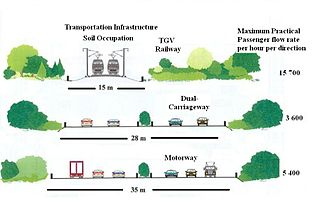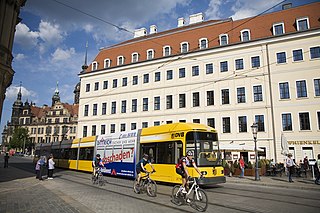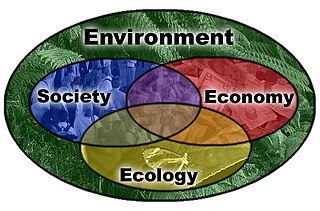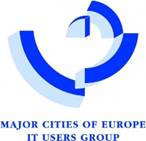
An intelligent transportation system (ITS) is an advanced application which aims to provide innovative services relating to different modes of transport and traffic management and enable users to be better informed and make safer, more coordinated, and 'smarter' use of transport networks.

Infrastructure is the set of facilities and systems that serve a country, city, or other area, and encompasses the services and facilities necessary for its economy, households and firms to function. Infrastructure is composed of public and private physical structures such as roads, railways, bridges, tunnels, water supply, sewers, electrical grids, and telecommunications. In general, infrastructure has been defined as "the physical components of interrelated systems providing commodities and services essential to enable, sustain, or enhance societal living conditions" and maintain the surrounding environment.
The digital divide is the unequal access to digital technology, including smartphones, tablets, laptops, and the internet. The digital divide creates a division and inequality around access to information and resources. In the Information Age in which information and communication technologies (ICTs) have eclipsed manufacturing technologies as the basis for world economies and social connectivity, people without access to the Internet and other ICTs are at a socio-economic disadvantage, for they are unable or less able to find and apply for jobs, shop and learn.
The global digital divide describes global disparities, primarily between developed and developing countries, in regards to access to computing and information resources such as the Internet and the opportunities derived from such access.

Information and communications technology (ICT) is an extensional term for information technology (IT) that stresses the role of unified communications and the integration of telecommunications and computers, as well as necessary enterprise software, middleware, storage and audiovisual, that enable users to access, store, transmit, understand and manipulate information.
Green computing, green IT, or ICT sustainability, is the study and practice of environmentally sustainable computing or IT.

Sustainable urban infrastructure expands on the concept of urban infrastructure by adding the sustainability element with the expectation of improved and more resilient urban development. In the construction and physical and organizational structures that enable cities to function, sustainability also aims to meet the needs of the present generation without compromising the capabilities of the future generations.

A sustainable city, eco-city, or green city is a city designed with consideration for social, economic, environmental impact, and resilient habitat for existing populations, without compromising the ability of future generations to experience the same. The UN Sustainable Development Goal 11 defines sustainable cities as those that are dedicated to achieving green sustainability, social sustainability and economic sustainability. They are committed to doing so by enabling opportunities for all through a design focused on inclusivity as well as maintaining a sustainable economic growth. The focus will also includes minimizing required inputs of energy, water, and food, and drastically reducing waste, output of heat, air pollution – CO2, methane, and water pollution. Richard Register, a visual artist, first coined the term ecocity in his 1987 book Ecocity Berkeley: Building Cities for a Healthy Future, where he offers innovative city planning solutions that would work anywhere. Other leading figures who envisioned sustainable cities are architect Paul F Downton, who later founded the company Ecopolis Pty Ltd, as well as authors Timothy Beatley and Steffen Lehmann, who have written extensively on the subject. The field of industrial ecology is sometimes used in planning these cities.

A zero-carbon city is a goal of city planners that can be variously defined. In a narrower sense of energy production and use, a zero-carbon city is one that generates as much or more carbon-free sustainable energy as it uses. In a broader sense of managing greenhouse gas emissions, a zero-carbon city is one that reduces its carbon footprint to a minimum by using renewable energy sources; reducing all types of carbon emissions through efficient urban design, technology use and lifestyle changes; and balancing any remaining emissions through carbon sequestration. Since the supply chains of a city stretch far beyond its borders, Princeton University's High Meadows Environmental Institute suggests using a transboundary definition of a net-zero carbon city as "one that has net-zero carbon infrastructure and food provisioning systems".

Computational sustainability is an emerging field that attempts to balance societal, economic, and environmental resources for the future well-being of humanity using methods from mathematics, computer science, and information science fields. Sustainability in this context refers to the world's ability to sustain biological, social, and environmental systems in the long term. Using the power of computers to process large quantities of information, decision making algorithms allocate resources based on real-time information. Applications advanced by this field are widespread across various areas. For example, artificial intelligence and machine learning techniques are created to promote long-term biodiversity conservation and species protection. Smart grids implement renewable resources and storage capabilities to control the production and expenditure of energy. Intelligent transportation system technologies can analyze road conditions and relay information to drivers so they can make smarter, more environmentally-beneficial decisions based on real-time traffic information.

The Major Cities of Europe IT Users Group is an independent association of chief information officers, IT managers and department heads of cities. The group was founded in 1982 as a result of an initiative by the Greater London Council. Since then it has focused on innovation in cities, driven by information and communications technology.

"Fourth Industrial Revolution", "4IR", or "Industry 4.0" is a buzzword and neologism describing rapid technological advancement in the 21st century. The term was popularised in 2016 by Klaus Schwab, the World Economic Forum founder and executive chairman, who says that the changes show a significant shift in industrial capitalism.

Smart cities seek to implement information and communication technologies (ICT) to improve the efficiency and sustainability of urban spaces while reducing costs and resource consumption. In the context of surveillance, smart cities monitor citizens through strategically placed sensors around the urban landscape, which collect data regarding many different factors of urban living. From these sensors, data is transmitted, aggregated, and analyzed by governments and other local authorities to extrapolate information about the challenges the city faces in sectors such as crime prevention, traffic management, energy use and waste reduction. This serves to facilitate better urban planning and allows governments to tailor their services to the local population.
Concept of smart villages is a global modern approach for off-grid communities. Vision behind this concept is to assist the policy makers, donors and socio-economic planner for rural electrification worldwide.
Sidewalk Labs LLC is an urban planning and infrastructure subsidiary of Google. Its stated goal is to improve urban infrastructure through technological solutions, and tackle issues such as cost of living, efficient transportation and energy usage. The company was headed by Daniel L. Doctoroff, former Deputy Mayor of New York City for economic development and former chief executive of Bloomberg L.P. until 2021. Other notable employees include Craig Nevill-Manning, co-founder of Google's New York office and inventor of Froogle, and Rohit Aggarwala, who served as chief policy officer of the company and is now Commissioner of New York City Department of Environmental Protection. It was originally part of Alphabet Inc., Google's parent company, before being absorbed into Google in 2022 following Doctoroff's departure from the company due to a suspected ALS diagnosis.
Cognitive city is a term which expands the concept of the smart city with the aspect of cognition or refers to a virtual environment where goal-driven communities gather to share knowledge. A physical cognitive city differs from conventional cities and smart cities in the fact that it is steadily learning through constant interaction with its citizens through advanced information and communications technologies (ICT) based ICT standards and that, based on this exchange of information, it becomes continuously more efficient, more sustainable and more resilient. A virtual cognitive city differs from social media platforms and project management platforms in that shared data is critical for the group's performance, and the community consists of members spanning diverse expertise, backgrounds, motivations, and geographies but with a common desire to solve large problems. The virtual cognitive city is steadily learning through constant metadata generated by activity in the user community.

The digital divide is a term used to describe the disadvantage in access to information which people without access to ICT suffer. Nigeria's digital divide refers to the inequality of Nigerian individuals, groups, or organizations with regard to access to Information and communications technology (ICT) infrastructure or to the internet for daily activities. The digital divide has been attributed to many factors among which is the high cost of computer equipment, lack of ICT skill and poor knowledge of available search engines. Lack of access to ICT makes it difficult for people to access information. The benefits of having access to ICT are numerous. ICT has the potential to promote other sectors of the economy such as agriculture, education, health, bank, defence etc. In times of emergency, ICT becomes an indispensable tool for overcoming the barriers of time and distance. Education, lack of electrical infrastructure, income, urban drift, and a variety of other social and political factors contribute to Nigeria's growing digital divide.
Smart tourism is an important component of a smart city. Tourism is one of the major components of economic growth for communities worldwide. A key requirement of tourism has been to attract more and more tourists from different parts of the world. Smart tourism refers to the application of information and communication technology, such similar to the smart cities, for developing innovative tools and approaches to improve tourism. Smart tourism is reliant on core technologies such as ICT, mobile communication, cloud computing, artificial intelligence, and virtual reality. It supports integrated efforts at a destination to find innovative ways to collect and use data derived from physical infrastructure, social connectedness and organizational sources, and users in combination with advanced technologies to increase efficiency, sustainability, experiences. The information and communication technology tools used for smart tourism include IoT, mobile communication, cloud computing, and artificial intelligence. It combines physical, informational, social, and commercial infrastructure of tourism with such tools to provide smart tourism opportunities. The principles of smart tourism lie at enhancing tourism experiences, improve the efficiency of resource management, maximize destination competitiveness with an emphasis on sustainable aspects. It should also gather and distribute information to facilitate efficient allocation of tourism resources and integrate tourism supplies at a micro and macro level ensuring that the benefits are well distributed. They are observed to be effective in technologically advanced destinations such as smart cities.
Sidewalk Toronto is a cancelled urban development project proposed by Sidewalk Labs at Quayside, a waterfront area in Toronto, Ontario, Canada. This project was first initiated by Waterfront Toronto in 2017 by issuing the request for proposal (RFP) on development of the Quayside area. Sidewalk Labs, a subsidiary of Google, issued the winning bid in 2017. The Master Innovation Development Plan (MIDP) was created in 2019 through conversations with over 21,000 Toronto residents and aimed to be an innovative reinvention of Toronto's neglected eastern downtown waterfront.












